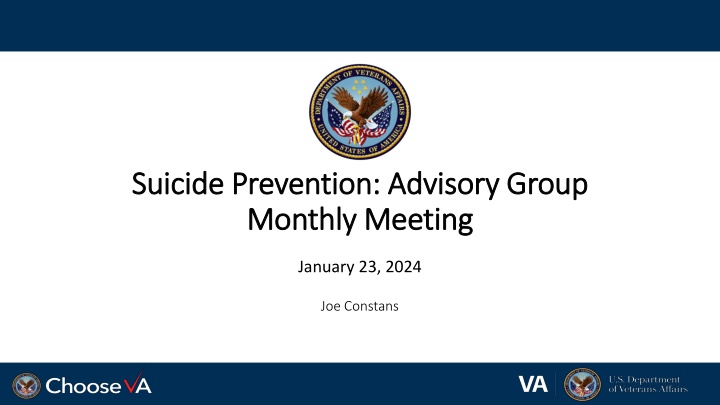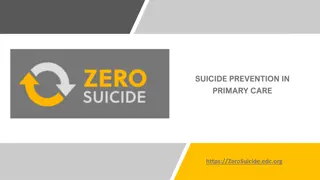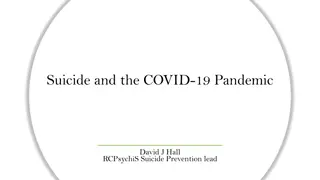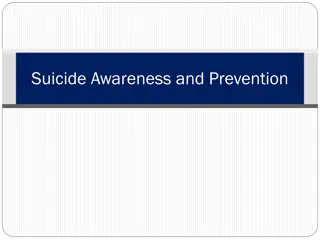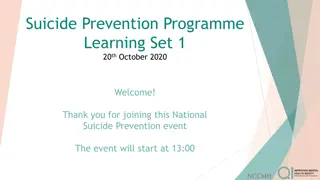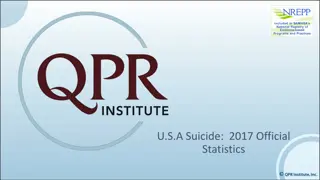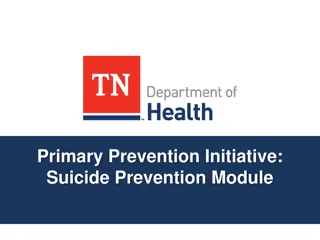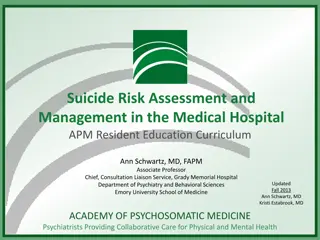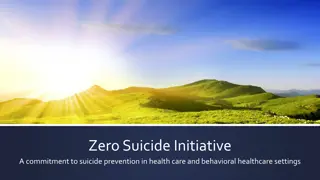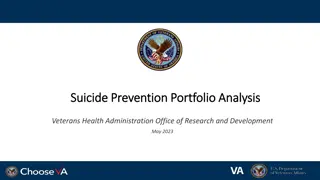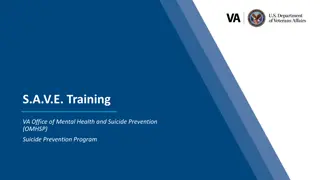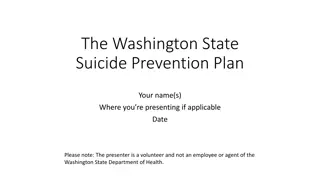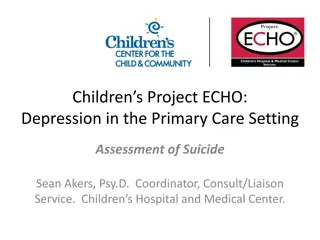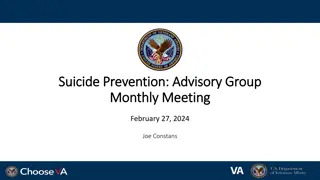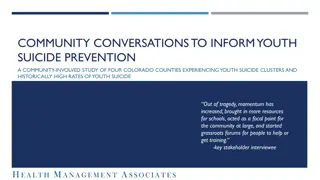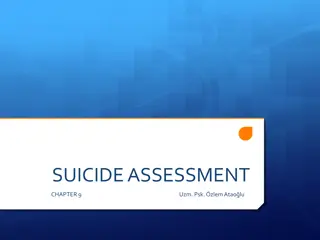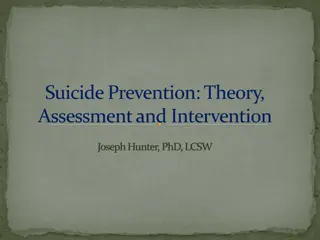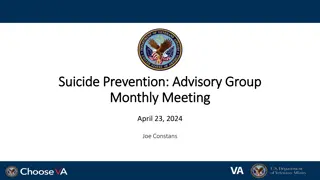Suicide Prevention Advisory Group: Monthly Meeting
The Suicide Prevention Advisory Group conducted their monthly meeting discussing various topics such as AMP activation, survey development, and priority setting in suicide prevention. Updates on the development of a Suicide Prevention AMP were shared, along with progress on portfolio analysis and upcoming tasks. The group aims to enhance understanding and strategies to prevent suicidal behavior through research and studies involving diverse methodologies.
Download Presentation

Please find below an Image/Link to download the presentation.
The content on the website is provided AS IS for your information and personal use only. It may not be sold, licensed, or shared on other websites without obtaining consent from the author.If you encounter any issues during the download, it is possible that the publisher has removed the file from their server.
You are allowed to download the files provided on this website for personal or commercial use, subject to the condition that they are used lawfully. All files are the property of their respective owners.
The content on the website is provided AS IS for your information and personal use only. It may not be sold, licensed, or shared on other websites without obtaining consent from the author.
E N D
Presentation Transcript
Suicide Prevention: Advisory Group Suicide Prevention: Advisory Group Monthly Meeting Monthly Meeting January 23, 2024 Joe Constans
Agenda Agenda Time Item Objective Present current state and upcoming tasks Review portfolio purview statement 3:00 3:05 Update on AMP activation Review priority setting process Review progress in Suicide Prevention priority development Priority Setting Process and Suicide Prevention AMP Priorities 3:05 3:15 Pain and Opiate Survey Recommendations from Investigators 3:15 3:30 Survey Development Suicide Prevention survey development Survey samples Use of data going forward 3:30 3:40 Discussion Review next steps in priority development 3:40 3:50 Next Steps
Update on Development of a Suicide Prevention AMP 3
Portfolio Stand Portfolio Stand- -up Progress up Progress Based on the Suicide Prevention workplan, the team plans to complete the designated documents by the end of these months. November Mar 2024 Mar - May 2024 Completed In Progress Future Items Role Charter Executive Committee Charter Purview Statement Portfolio Analysis Report Portfolio Analysis PPT Position Description Critical Research Priorities Portfolio RFAs / Program Announcements Funding Model SOP Portfolio Performance Metrics
Suicide Prevention Actively Managed Portfolio: PURVIEW STATEMENT The Suicide Prevention Actively Managed Portfolio (AMP) will include research involving preclinical, translational, clinical, and health services/implementation studies that seek to improve the understanding of suicide and prevent suicidal behavior. Contained within this portfolio will be research using a wide variety of methods and approaches including, but not limited to, studies involving animal models, human tissues and genetic samples, clinical trials of pharmacological and non-pharmacological treatments, application of new technologies, implementation studies (including hybrid studies), observational and epidemiological studies, development of assessment measures, studies concerning risk identification, and studies that seek to understand or address the influence of community on suicidality including investigations on family, caregiver, and peer support, as well as investigations on education, public service announcements, recreation, housing, geospatial location, and employment. 5
Last Meeting Recall: Rapid (and Rigorous) Approach to Identifying AMP Research Priorities Last Meeting Recall: Rapid (and Rigorous) Approach to Identifying AMP Research Priorities Survey and focus group input inform Delphi consensus panel discussion with representatives from different groups Phase II: Refine Priorities using concurrent processes: national surveys/live voting & focus groups with Consumer, Provider, Leader, Investigator groups Existing reviews inform focus group, survey questions Phase I: Identify research gaps and unanswered questions (e.g., SPM review, evidence inventories or reviews, VA program office strategic plans) Phase III: Delphi consensus panel with interested party representatives rank priorities on urgency, impact, feasibility, identify impact metrics AMP Priorities for RFA General principles: 1. Priorities should reflect the research translation spectrum (e.g., T1-T4) 2. In-depth feedback from focus groups to identify topics not previously listed 3. Broad representation across interested parties via surveys, voting on top priorities 4. Perspectives from the front line References: 1. Aligning quality improvement efforts and policy goals in a national integrated health system - Braganza - 2022 - Health Services Research - Wiley Online Library; 2. Health System Research Priorities for Children and Youth With Special Health Care Needs - PubMed (nih.gov), 3. Research Lifecycle to Increase the Substantial Real-world Im... : Medical Care (lww.com) Measures of Impact Exec. Committee
Phases to determine Critical Research Priorities Phases to determine Critical Research Priorities 1. Reviewing existing literature around suicide prevention research priorities 2. Refining the collected priority list by conducting surveys and discussing priority topics with focus groups. Ranking of topics using structured survey. 3. Holding a consensus panel with the portfolio s executive committee to review priorities and rank based on urgency, impact, and feasibility Braganza, M. Z., Pearson, E., Avila, C. J., Zlowe, D., vretveit, J., & Kilbourne, A. M. (2022). Aligning quality improvement efforts and policy goals in a national integrated health system. Health Services Research, 57, 9-19.
Phase 1: Critical Research Priority Setting for Suicide Prevention Phase 1: Critical Research Priority Setting for Suicide Prevention American Foundation for Suicide Prevention Utilizing these sources as a base, the team gathered priorities from a total of 26 sources, resulting in 186 cumulative priorities American Psychological Association CDC Defense Health Agency (DHA) Department of Defense Indian Health Service National Action Alliance for Suicide Prevention (NAASP) NAMI These priorities were coded into research categories to reflect method/procedure and characteristic of prioritized population. NIMH SAMSHA VHA White House Peer-reviewed Research 9
Phase 1: Developing the Priority Matrix Phase 1: Developing the Priority Matrix Younger Veterans (22- 34) Older Veterans Female Veterans Race/Ethnicit y Substance Abuse Medical Disease Justice Involvement Trauma/ Moral InjuryMental Health Cross- Cutting Firearms SDOH TBI LGBTQ Category Biology/ Genomics/Brain Risk Factor Assessment/ Screening - clinician/questionnaire Risk Factor Assessment - machine learning Continuous monitoring Family /Social Network Pharmacotherapy and other Somatic Interventions Psychotherapy and other Non-Somatic Interventions Community Interventions Education, Training, & Messaging Precision Medicine ? Cross-Cutting Postvention First Column Categories reflect Method or Procedure. First Row Categories reflect Risk Factors A priority could be placed into a cell reflecting risk factor and method.
Phase 2: Gathering input from various stakeholders Phase 2: Gathering input from various stakeholders Priority Questionnaire Distribution to Field (November 17, 2023) A survey was sent out to investigators within the SPRINT database. We collected responses from 54 respondents, each listing ranked research priorities. These priorities were coded into the categories developed in Phase 1. Veteran s Engagement Council Discussion (December 7, 2023) Our team met with a Veteran s Engagement Council in December to hold a discussion and gather research topics of interest to veterans. VISN Suicide Prevention Lead Open Discussion (January 11, 2024) Understanding Research Priorities from the perspective of VISN Leads for Suicide Prevention Coordinators. Discussion with VA Investigators (January 19, 2024) Discussion of qualitative data obtained and solicitations of recommendations for quantitative survey.
Phase 2: Priority Questionnaire Distribution to Field Phase 2: Priority Questionnaire Distribution to Field Greetings VA Suicide Prevention investigators, Beginning October 1, 2024, suicide prevention research will be housed within the Suicide Prevention Actively Managed Portfolio (SP AMP). The SP AMP team is currently working with an Executive Steering Committee to establish governance policy and processes for the SP AMP and to establish initial priority areas for VA suicide prevention research. The priority setting efforts will follow a strategy developed by QUERI which seeks input from multiple stakeholders throughout the priority setting process. As part of our initial efforts, we are asking for your assistance in identifying topic areas that you believe are important to advance suicide prevention efforts in VA. To help us gather a thorough body of topic areas, we ask that you identify up to 10 research areas for which there are significant gaps in extant knowledge and for which research support is needed. If you are willing to assist us in these initial efforts to identify possible priority areas, please click on this link which will provide further instruction. Please provide feedback as soon as possible but no later than November 17th. Thanks in advance for your willingness to help. We will be providing more information to the field as this process advances.
Phase 2: Categorizing Priority Questionnaire Responses Phase 2: Categorizing Priority Questionnaire Responses Initial Categorization of Priorities Identified by Survey Respondents Younger Veterans (22- 34) Female Veterans Substance Abuse Justice Involvement Trauma/ Moral Injury Category Cross-Cutting Firearms Older Veterans Race/Ethnicity SDOH Medical Disease TBI LGBTQ Mental Health SUM Biology/ Genomics/Brain 45 0 0 0 0 0 0 0 0 0 0 0 0 0 45 Risk Factor Assessment/ Screening - clinician/questionnaire 25 0 5 5 0 0 8 0 10 0 0 0 0 3 56 Risk Factor Assessment - machine learning 22 0 0 0 0 0 0 0 0 0 0 0 0 0 22 Continuous monitoring 13 0 0 0 0 0 0 0 0 0 0 0 0 0 13 Family /Social Network 13 6 0 0 0 0 0 0 0 0 0 0 0 0 19 Pharmacotherapy and other Somatic Interventions 29 0 0 0 0 0 0 0 0 0 0 0 0 1 30 Psychotherapy and other Non-Somatic Interventions 42 25 0 0 0 0 22 0 0 0 0 5 5 1 100 Community Interventions 56 7 0 5 0 0 0 0 0 0 0 0 0 0 68 Education, Training, & Messaging 17 10 0 0 0 0 0 0 0 0 0 0 0 0 27 Precision Medicine ? Cross-Cutting 6 5 0 0 0 3 0 0 0 0 2 0 4 0 4 0 5 0 0 6 0 6 49 34 25 16 32 31 18 Postvention 16 0 0 0 0 0 0 0 0 0 0 0 0 0 16 SUM 97 39 13 25 16 62 2 14 4 5 36 11 23
Phase 2: Potential Priorities as identified through Matrix coding Phase 2: Potential Priorities as identified through Matrix coding Category Example Responses to Unstructured Survey Psychotherapy and other Non- Somatic Interventions Multi-site RTC to determine interventions most likely to prevention suicide death. Firearms, Lethal Means Safety Does LMS counseling in primary care settings reduce suicide deaths? Community Interventions What community interventions effectively promote safe storage? Social Determinants of Health Do programs that address SDOH (i.e., providing housing to unhoused Veterans) decrease suicide for those at risk? Risk Factor Assessment Screening How can algorithms be improved to include dynamic risk factors of suicide? Biology, Genomics, Brain Neuroimaging (fMRI, DTI, MRS) studies of suicide: emphasis on measures of impulsivity, negative affect processing, reward, decision making. Older Veterans Developing age-specific interventions for older Veterans. LGBTQ+ Interventions for sexual minority / LGBQ veterans. 14
Phase 2: Veterans Engagement Council Discussion Phase 2: Veteran s Engagement Council Discussion Key Questions for Audience: Research Priorities Discussed during Meeting Hard to Reach Veterans (Isolating Veterans/ Veterans not in VA care/ Rural Veterans / Transitioning to civilian) Continuity of Care* Community Research (including family) Developing Novel Treatments (including provider perspective) Moral Injury/Spiritual Lethal Means Safety Messaging Peer Support Messaging Data Studies Racial/Ethnic/Sexual Minorities Brain/TBI/Genomics (low priority) 1. What suicide prevention research topics come to mind as most important for Veterans from your perspective? 2. Are there specific patient populations it would be important to study (if this has not come up)? 3. Are there any research topics you don t think are as high a priority? 4. Are there particular topics within this area that come to mind that would be important for VA researchers to work on? 15 * - category not identified through investigator survey
Phase 2: VISN Suicide Prevention Lead Phase 2: VISN Suicide Prevention Lead Open Discussion Open Discussion Key Questions for Audience: Research Priorities Discussed during Meeting Risk Identification Process* Needs modification Clinician burden too high Clinical Trial Feasibility* Psychotherapy Small trials will not advance practice Community Interventions Education, Training, and Messaging Firearms, Lethal Means Safety Safety Planning Older Veterans Female Veterans 1. What areas in suicide prevention do you think needs more research to support your clinical decision-making? 2. How does your program implement current research evidence or data regarding assessing suicide risk? What would make risk assessment processes or resulting risk information more useful or actionable? 3. How do you use the information you have now regarding effectiveness of suicide prevention interventions and treatments? What new information would help your program make evidence-informed treatment planning decisions? 4. Are there certain patient characteristics that are important to study or to include in VA research? * - similar category / different perspective 16
Phase 3: Pain/Opioid Use AMP Survey Phase 3: Pain/Opioid Use AMP Survey Purpose: The VHA Pain and Opioid actively managed portfolio in the Office of Research and Development is requesting input on research priorities related to pain and opioid use experienced by Veterans. This survey is part of a larger initiative to obtain input on research priorities from different groups including clinical leaders, researchers, Veterans, and the frontline providers who care for them. For research priorities related to pain, please consider different types of pain such as neuropathic pain (e.g., due to damages in the nervous system) as well as for musculoskeletal pain (e.g., due to damages to the connective tissues including bones, muscles, etc.). For research priorities related to opioids, please also consider accidental opioid overdose rescue and the effects of opioid tapering. For both pain and opioid use, we are interested in your input on research priorities across the scientific translation spectrum: Basic research (e.g., understanding biological bases for pain and addiction) Clinical research (e.g., testing new treatments and understanding their mechanisms) Health systems and policy (e.g., long-term outcomes of treatments, how to implement effective treatments, and understanding how to optimize programs and polices based on socio-economic factors) Responses will be confidential and aggregated to help inform VHA research funding priorities.
Phase 3: Pain/Opioid Use AMP Survey Phase 3: Pain/Opioid Use AMP Survey Q.1. The following is a list of currently identified VHA research priorities related to opioid use disorder and pain management. Your feedback on these research priorities will help inform a VA program of research that is focused on improving outcomes for Veterans with opioid or other substance use disorders, as well as those experiencing pain. At the end you also have an opportunity to write in other specific priorities not included in this list. Please select and rank your top three research priorities. [Priority option order will be randomized] (X) Clinical studies of the genetic, anatomical, and behavioral bases of pain, tolerance, addiction, opioid metabolism, and tapering of opioid medication (X) Research on the risk factors, treatment, and prevention of opioid use disorder resulting from fentanyl-based products, prescription painkillers, and heroin products (X) Preclinical development and translation of non-opioid therapies, including medications, complementary and integrative approaches; and the accompanying anatomical, molecular, biochemical, behavioral, and genetic mechanism(s). (X) Studies identifying therapeutic targets for pain, tolerance, and/or opioid use disorder in acute and chronic painful conditions. (X) Experimental and observational interventional to improve outcomes in opioid use disorder, including new models for opioid use disorder and substance use disorder care, medication and behavioral therapy for opioid use disorder, use of overdose rescue medication, and self-help groups. (X) Examination of pharmacology, pharmacotherapeutics, pharmacogenomics, and phenotypes as well as the use of functional outcomes (e.g., correlating subjective pain measures with objective measures of function such as ADL, gait kinetics and kinematics, range of motion, and Quality of Life or activity measures, etc.). (X) Clinical treatments for long-term recovery from pain emphasizing non-opioid medications and complementary and integrative approaches. This includes studies that use novel designs including pragmatic trials or cluster randomized trials to maximize study sample size, retention, and enrollment from typical practice or community settings. (X) Implementation of treatments and approaches across VAMCs, evaluation of methods to enhance pain services, and evaluation of the quality and safety of pain care, especially for underserved and marginalized groups (e.g., people with sickle cell risk). (X) Environmental and/or policy interventions that address social determinants to prevent opioid misuse and promote effective opioid use disorder treatment retention and recovery over time. Non-comprehensive examples include Veterans benefits programs, policy interventions for at-risk and marginalized groups, or jail diversion programs such as drug courts.
Phase 3: Pain/Opioid Use AMP Survey Phase 3: Pain/Opioid Use AMP Survey Q.2. Other research priority not previously listed Please Specify Q.3. If you have any additional comments or ideas regarding the VHA research priorities related to opioid use disorder and pain management, please use the space below. Q.4. If you have any additional comments regarding the VHA research prioritization process related to opioid use disorder and pain management, please use the space below.
Phase 3: Discussion with Investigators to develop Survey Phase 3: Discussion with Investigators to develop Survey Suggestions regarding weighting of quantitative and qualitative data to identify content domains for consideration? Thoughts on ranking or rating of content domains in the survey? That is, what do you see as the benefits of ranking over rating and visa versa? How many domains should be considered on the survey? What are the recommendations regarding specificity in the domains in survey? For example, if Lethal Means Safety Should we leave it at the content domain (Lethal Means Safety) Or should we present different options regarding intersection between population and methods (i.e., LMS in primary care; LMS in community) 21
Phase 3: Recommendations from Investigators on Survey Format Phase 3: Recommendations from Investigators on Survey Format Survey Content Use of count data Include themes important to non-investigator stakeholders Recommended different instructions Framing language to define what is meant by important Broad Categories Rate categories Rank top 3 categories Specify what should be studied in top 3 categories Populations Rank each population 22
Next Steps 23
Next Steps and Discussion Next Steps and Discussion Identification of all recipients for Survey Distribution of Suicide Prevention Survey Selection of experts to present priority topics Consensus Panel Meeting 24
